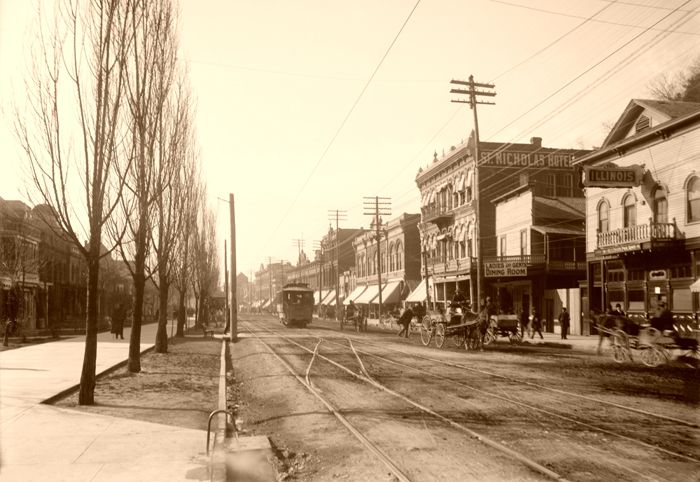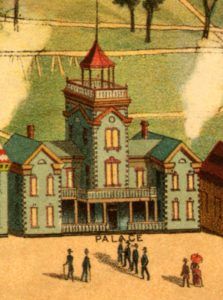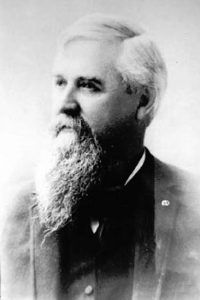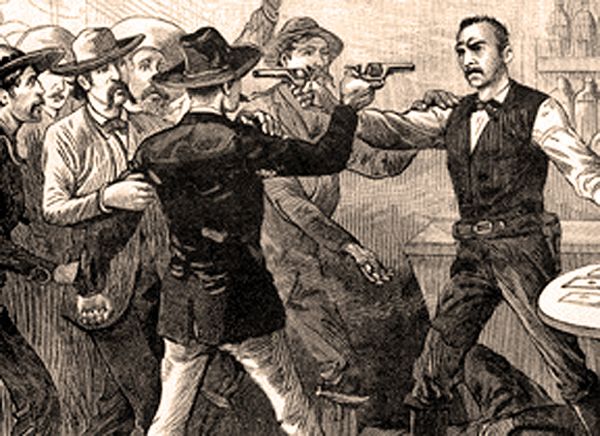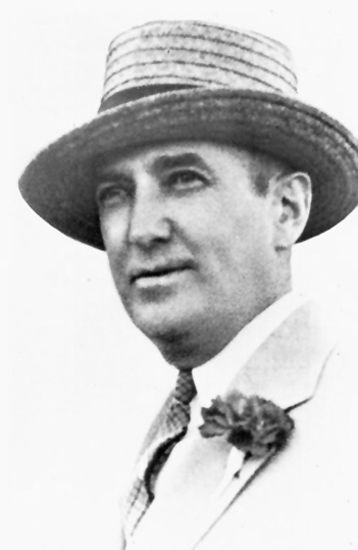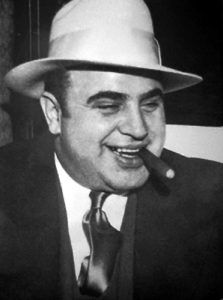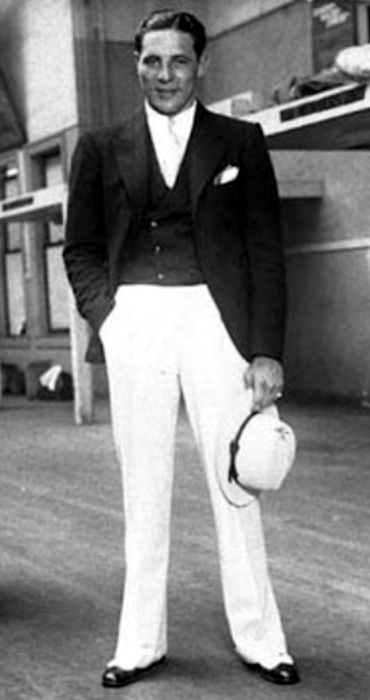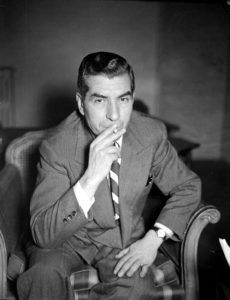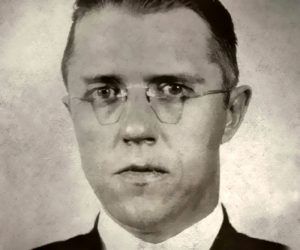Though visitors of Hot Springs, Arkansas, today don’t see the gambling, prostitution, bootlegging, and gangsters that were once rampant in the spa city, these operations had a strong foothold for decades, especially in the 1930s.
Illegal gambling occurred in the city as early as the mid-1800s and was firmly established following the Civil War. By the late 1870s, gambling had become an industry rivaling the hot springs’ healing waters. During this time, a Canadian gambler named Frank Flynn had arrived in the city and, by the early 1880s, was in control of the gambling operations and many of the brothels. By paying law enforcement officers of the Police Department and Sheriff’s Office, he prevented any intervention in his illegal activities. Flynn, most often called “Boss Gambler,” either owned or controlled seven gambling houses, and any who dared to enter Hot Springs and attempt to open up a rival gambling house were dealt with by the police.
One man who dared to do so was Jim Lane, a gambling entrepreneur from Illinois who arrived in about 1880. Lane soon opened two high-end gambling halls — the Palace and the Monarch. Lane refused to align with Flynn or pay a percentage to him for the right to operate his business. In response, Flynn and several other men attacked and wrecked the Palace Casino. During the attack, one of Lane’s dealers killed one of Flynn’s thugs. Afterward, Lane fled Hot Springs and traveled to New Orleans, Louisiana.
By the summer of 1882, many people were tired of illegal gambling and some of the shady elements it brought to the city. One of these people was Charles Matthews, the editor of the Hot Springs Daily Hornet, who raged against gambling and Mayor T.F. Linde for doing nothing to stop it. Shortly afterward, Mayor Linde, who also served as a judge then, was so angered that when he met Matthews on the street, he pulled out his pistol and began firing. When the smoke cleared, Linde had shot and wounded Matthews three times and wounded a peddler and city councilman in the line of fire. Amazingly, the mayor was neither charged nor removed from office.
After the newspaper editor recovered from his wounds, he renewed his attacks on illegal gambling and the mayor and several other prominent men involved in the gambling business. Two of these citizens included the wealthy and powerful Samuel L. Fordyce and his partner, D.C. Rugg, who owned an interest in the Arlington Hotel and its gambling club. His article implied that the two men were in cahoots with none other than “Boss Gambler” Frank Flynn and labeled the trio the “Arlington Gang.” After this appeared in the newspaper, Samuel Fordyce approached Matthews on Central Avenue and struck the newspaperman with his cane. Pulling his pistol in self-defense, Matthews fired but missed. D.C. Rugg pulled his gun, and Matthews fired again, hitting Rugg in the leg. Matthews, who was wounded, was able to retreat down the street but was followed by Frank Flynn, who fired a final shot at Matthews, killing the editor. Fordyce, Flynn, and Rugg were all charged with manslaughter. Ultimately, Flynn and Rugg were acquitted, while Fordyce was fined $200 for starting the conflict when he attacked Matthews with his cane.
In the winter of 1883, a new player came to town — former Confederate Major S.A. Doran. Doran had met Jim Lane in New Orleans, who had been run out of Hot Springs and his Palace Casino by Frank Flynn. Whether Doran decided to avenge his friend or simply liked a good fight, he decided to go to Hot Springs and challenge the gambling kingpin. Upon his arrival, he reopened the Palace Casino, refused to join Flynn’s gambling ring, and all attempts at intimidating him were ineffective.
The first violence occurred when Flynn challenged Doran to a duel not long after his arrival, which resulted in Flynn being shot once in the chest but not fatally. Afterward, there were other clashes between the two factions, with men being murdered on each side. During this violent time, Doran killed ten men before he was killed in 1888. Afterward, Flynn continued to control the gambling operations and used the city police department to collect his debts and to force the competition to leave town.
Though Doran was dead, the feud continued into the 1890s, with the Hot Springs Police and the Garland County Sheriff’s Department in the middle as the two factions clashed over which law enforcement agency would control illegal gambling activities in Hot Springs and its profits in the form of graft and kickbacks. This led to the Hot Springs Gunfight between the two groups on March 16, 1899. After the gunfight, a Citizens Commission forced Frank Flynn out of town. However, illegal gambling did not go away, and corruption within both law enforcement agencies remained well into the 20th century.
Within this arena of corruption, Hot Springs continued its illegal gambling habits. By the 1920s, the city was filled with hotel rooms, saloons, and back alleys that included casino-type gaming of all kinds. In 1926, Leo McLaughlin was elected mayor. He fulfilled a campaign promise to run Hot Springs as an “open” town, which included legal gambling and overlooked hotels that advertised the availability of prostitutes, and off-track booking was available for virtually any horse race in North America. As mayor, McLaughlin reigned as the undisputed boss of Garland County politics for the next 20 years. However, McLaughlin took it to a new level, using voter fraud and other unlawful tactics to drive his political machine. During his tenure, local law enforcement was controlled by a political machine and a former sheriff, who attempted to have the state’s anti-gambling laws enforced and to secure honest elections but was murdered in 1937. No one was ever charged with his killing.
Between 1927 and 1967, Hot Springs operated the most considerable illegal gambling racket in the country. In the 1930s, over a million baths a year were given, and Hot Springs became America’s first resort.

The Southern Club in Hot Springs, Arkansas, was often frequented by gangsters in the 1920s. Today, the building serves as Josephine Tussaud’s Wax Museum. Photo by Detroit Publishing, 1900.
During McLaughlin’s time in office, many underworld characters frequented Hot Springs’ spas, and gambling became one of the town’s most popular forms of entertainment. Some of these infamous names included Owen Vincent “Owney” Madden, Bugs Moran, Charles “Lucky” Luciano, and Al Capone. A few of their favorite hangouts were the Southern Club, which now houses Josephine Tussaud’s Wax Museum; the Ohio Club, now considered to be the oldest bar in Arkansas; the Arlington Hotel, which still entertains guests; and the Oaklawn Race Track, which is still open today.
Al Capone first came to Hot Springs in the early 1920s during the Prohibition era, and he and his boss, Johnny Torrio, stayed at the Majestic Hotel. During this time, Capone and his men came to town to strike deals with the many moonshiners in the area. Soon, he purchased an underperforming dairy outside of town and turned it into his own moonshine distillery. Mimicking the water products of the Mountain Valley Spring Water Company, which had been distributing water from Hot Springs since 1871, Capone placed his moonshine in clear glass bottles and called his product Mountain Valley Water. He would then smuggle his bootleg liquor in tanker railroad cars.
When the new Arlington Hotel opened its doors on New Year’s Day 1925, Capone often rented the entire 4th floor for himself and his entourage. Al and his brother Ralph were often known to frequent Hot Springs, where they enjoyed the horse races at Oaklawn Park, golfed regularly, enjoyed the bathhouses, and partook of the many gambling facilities. Though Capone often had as many as 40 men accompany him, all of whom were known to be violent thugs in Chicago, while they were in the spa city, they were peaceful, polite, friendly, and appreciated as generous tippers. By 1929, Capone was arrested several times and finally sent to prison for tax evasion in 1931. By his release in 1939, he was physically and mentally ill. He died in Florida in 1947. Today, suite 443 in the Arlington Hotel still bears his name.
One of the most notorious of the many mobsters that spent time in Hot Springs was Owney “The Killer” Madden. After serving a year in Sing-Sing Prison for parole violations, Madden was released in 1933 and began to visit Hot Springs, seeking a slower lifestyle than the one he had lived in New York City. By then, Madden was in his forties and chronically ill because of old bullet wounds. There, he met a gift shop clerk, Agnes Demby, the daughter of the local postmaster. He married her in November 1935 and settled in Hot Springs for the rest of his life. Having made a fortune in New York City in illegal liquor revenue during Prohibition and as the owner of Stork Club and the Cotton Club, Madden could have retired but instead applied his organizational skills to the large, and soon be larger, illegal gambling operations of Hot Springs.
Madden quickly settled into Hot Springs, well-respected, well-liked, and generous to the community. Before long, many of his old acquaintances from New York began to visit him, including Meyer Lansky, Lucky Luciano, Bugsy Siegel, Dutch Schultz, and even his Sing Sing warden, Lewis Lawes. Word soon spread that Hot Springs was the perfect hideout for criminals running from police investigations. Madden was reputed to have owned an interest in the Southern Club, as well as becoming the overlord of the city’s illicit gambling activities. Madden spent the rest of his life in Hot Springs until he died of emphysema in April 1965 and was buried in Greenwood Cemetery.
On April 1, 1936, when Charles “Lucky” Luciano was visiting, he was not so lucky as the Hot Springs Police Department detained him on orders from Thomas Dewey, the New York State Attorney General. As he was walking along federal property along Bathhouse Row with none other than Hot Springs chief of detectives Herbert “Dutch” Akers, he was arrested. However, a local judge released Luciano after a $5,000 bond was paid. An enraged Dewey contacted the Arkansas governor and state attorney, demanding action, but Hot Springs officials were reluctant to begin extradition hearings. A new fugitive warrant was issued on April 3, and 20 state troopers were sent to collect Luciano and move him to Little Rock, Arkansas. A $50,000 bribe was made to deny the extradition, but the authorities couldn’t be bought. Within days, Luciano was returned from Arkansas to New York to stand trial for running a prostitution racket. He spent the next ten years in Dannemora Prison in New York before being released in 1946. He was then deported back to Italy, where he spent the rest of his life.
Alvin “Creepy” Karpis, America’s last official Public Enemy No. 1, often made Hot Springs his hideout. Although most well known for committing crimes throughout the Midwest, the Barker-Karpis Gang’s first murder occurred in Pocahontas, Arkansas, in 1931, and the gang members later holed up in Hot Springs. By 1935, most of the gang members had been killed or imprisoned, but Alvin Karpis was still on the run for two kidnappings. In June 1935, Karpis headed to Hot Springs again, taking refuge at the Hatterie Hotel managed by Grace Goldstein. She and Karpis soon developed a romantic relationship and are often referenced as having a common-law marriage. Goldstein also managed a brothel above the Hatterie, and the corrupt Hot Springs Police generally overlooked the joint. Later, Karpis and one of his accomplices, Fred Hunter, stayed at Lake Catherine and Lake Hamilton nearby before renting a house between Malvern and Hot Springs. On March 30, 1936, the FBI raided the house only to find that the two had already fled to New Orleans, Louisiana. FBI agents later apprehended both, and in July, Karpis pleaded guilty to kidnapping and was sent to Alcatraz. After serving nearly 33 years, he was released in 1968. He died in 1979 from an overdose of sleeping pills while living in Spain.
Although some of these criminals would get their “just due” and never again visit Hot Springs, the city remained a haven for criminals looking to hide. Bugsy Siegel, Jimmy Blue Eyes, and Frank Costello would continue to visit Hot Springs into the 1960s. Some historians even contend that Bugsy Siegel’s vision for the Flamingo Hotel in Las Vegas, Nevada, came from his many visits to the casinos of Hot Springs. Albert Anastasia, seeking business advice from Owen Madden, was in Hot Springs just days before he was gunned down at the Park Sheraton Hotel in New York. Meyer Lansky would regularly bring his son, Buddy, for treatment of cerebral palsy at Hot Springs’ Levi Hospital.
However, gangster activity and other illegal activities in Hot Springs came to an end in the 1960s due to a federal crackdown on what the government called “the site of the largest illegal gambling operation in the U.S.”
In 1967, two Republican officeholders, Governor Winthrop Rockefeller and Circuit Judge Henry M. Britt, began to enforce the existing state laws and eliminate the gambling laws made legal in Hot Springs. The governor sent a company of state troopers to shutter the casinos and burn their gaming equipment. Afterward, the only legal form of gambling was at Oaklawn Park, a thoroughbred horse racing track south of downtown Hot Springs.
© Kathy Alexander/Legends of America, updated January 2024.
Also See:
Gangsters, Mobsters & Outlaws of the 20th Century
Hot Springs – Home of Healing Waters
Sources:
Gangster Museum
Hanley, Ray; A Place Apart: A Pictorial History of Hot Springs, Arkansas; University of Arkansas Press, 2011.
Hot Springs Arkansas
Only in Your State
Wikipedia

